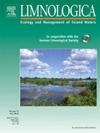海口市城市河流鱼类重金属生物积累、稳定同位素比值及人体健康风险
IF 2
4区 环境科学与生态学
Q2 LIMNOLOGY
引用次数: 0
摘要
尽管有毒金属是一种重要的食物来源,但它也可能通过食用受污染的鱼类转移给人类,造成健康风险。对稳定同位素比率的研究提供了对污染源以及污染物如何进入水生生物饮食的深入了解。河流提供鱼类,是人类重要的食物来源;因此,评估鱼类体内的金属污染至关重要。但目前对海口市城市河流重金属污染的研究还比较有限。基于此,本研究对海口市3条城市河流中7种淡水鱼的重金属生物积累和碳(δ13C)、氮(δ15N)稳定同位素比值进行了评价。还评估了重金属对人体健康的潜在风险。鱼鳃的Fe、Mn、Cu、Zn、Ni、Cd、Pb、Co含量显著高于肌肉(p < 0.05)。金属含量在鱼种类型、摄食习性和生境上存在显著差异(p < 0.05)。其中,绒螯虾(Anabas testudineus)和麻螯虾(Parachromis managuensis)的含量最高、最低。草食性鱼类的金属浓度最高,而食肉动物的最低。δ¹³C的同位素比值为-32.32‰至- 14.47‰,δ¹5 N的同位素比值为3.22‰至14.29‰,表明能量来源和营养水平广泛。杂食性鱼类的δ¹³C高于食肉动物和食草动物。就生活环境而言,底栖鱼类和底栖鱼类的δ¹³C和δ¹5 N值分别很高。金属浓度与鱼的长度和重量呈负相关,表明存在生物稀释。相比之下,Pb和Hg与δ 1 5 N正相关,表明沿食物链有生物放大作用。部分鱼类砷和铬的目标危害商(THQ) > 1,提示存在潜在的健康风险。一般情况下,中华绒螯蟹、紫齿螯蟹、大头绒螯蟹、nilochromis niloticus、mossambicus Oreochromis危害指数(HI)均在1以上;因此,食用它们可能损害人体健康。该研究提供了有关重金属污染和鱼类生物积累的信息,为公共卫生和金属污染控制提供了有用的信息。本文章由计算机程序翻译,如有差异,请以英文原文为准。
Heavy metal bioaccumulation, stable isotope ratios, and human health risks of fishes from urban rivers in Haikou City, China
Despite its importance as a food source, toxic metals may also be transferred to humans by consuming contaminated fish, causing health risks. Studies on stable isotope ratios provide insight into contamination sources and how the pollutants get into the diet of aquatic organisms. Rivers provide fishes, which form a substantial human food source; hence assessing metal contamination in fish is vital. However, studies are limited on heavy metal contamination in urban rivers in Haikou City, China. Accordingly, this study assessed the heavy metal bioaccumulation and stable isotope ratios of carbon (δ13C) and nitrogen (δ15N) in seven freshwater fish species collected from three urban rivers in Haikou City. The potential heavy metal human health risk was also assessed. Fish gills had significantly (p < 0.05) high Fe, Mn, Cu, Zn, Ni, Cd, Pb, and Co content than muscles. The metal content differed significantly (p < 0.05) regarding fish species type, feeding habits, and living habitat. For example, Anabas testudineus and Parachromis managuensis had the highest and lowest levels, respectively. Herbivorous fishes had the highest metal concentrations, while carnivores had the lowest. The isotope ratios ranged from -32.32‰ to - 14.47‰ for δ¹³C and 3.22‰ to 14.29‰ for δ¹⁵N, suggesting wide energy sources and trophic levels. Omnivorous fishes had a higher δ¹³C than carnivores and herbivores. Regarding living habitats, benthopelagic and demersal fishes had high values of δ¹³C and δ¹⁵N, respectively. The metal concentration correlated negatively with fish length and weight, suggesting a biological dilution. In contrast, Pb and Hg positively correlated with δ¹⁵N, indicating biomagnification along the food chain. The target hazard quotient (THQ) of As and Cr were > 1 in some fishes suggesting potential health risks. Generally, the hazard index (HI) of Anabas testudineus, Coptodon zillii, Mugil cephalus, Oreochromis niloticus, and Oreochromis mossambicus were above 1; thus, their consumption may impair human health. The study provides information on heavy metal contamination and bioaccumulation in fish, which is useful to inform public health and metal pollution control.
求助全文
通过发布文献求助,成功后即可免费获取论文全文。
去求助
来源期刊

Limnologica
环境科学-湖沼学
CiteScore
3.70
自引率
5.90%
发文量
64
审稿时长
3 months
期刊介绍:
Limnologica is a primary journal for limnologists, aquatic ecologists, freshwater biologists, restoration ecologists and ecotoxicologists working with freshwater habitats.
 求助内容:
求助内容: 应助结果提醒方式:
应助结果提醒方式:


